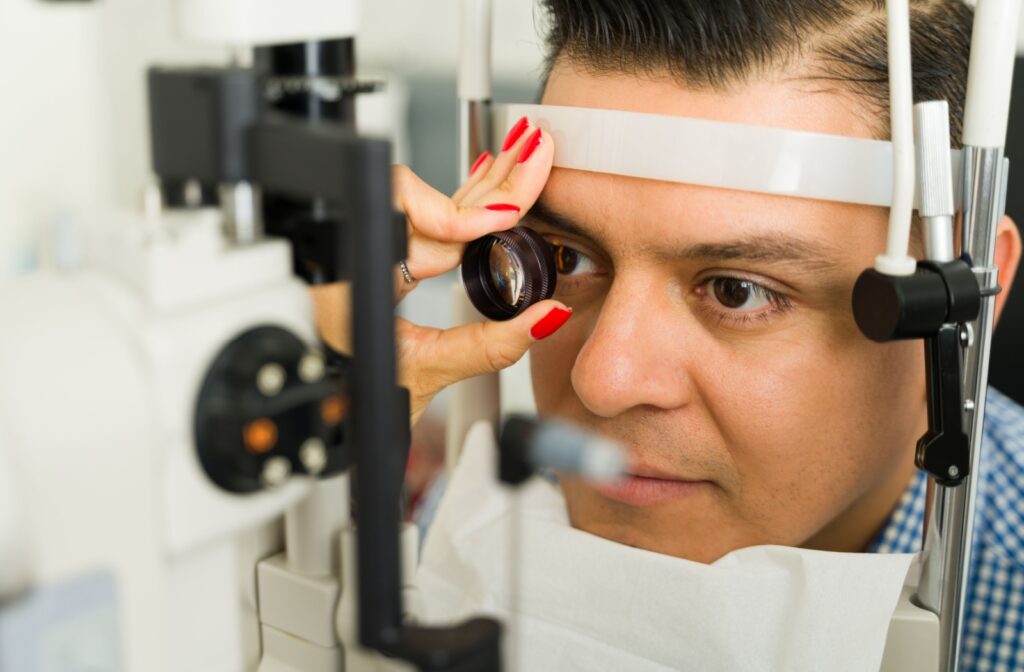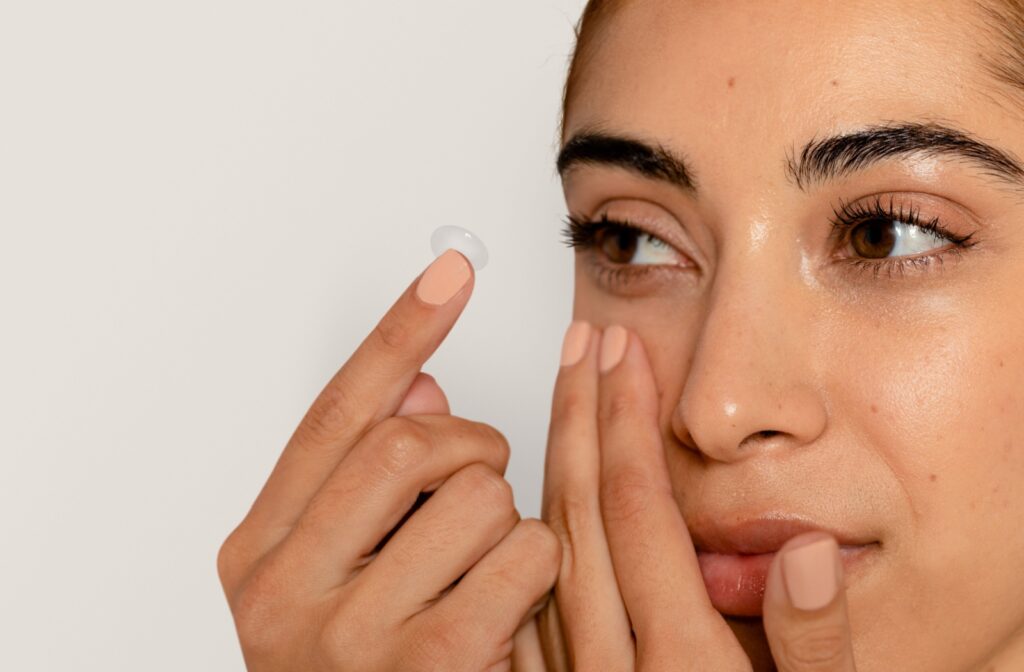Scleral contact lenses are designed for people with corneal irregularities, severe dry eye, or complex prescriptions. Designed to vault over the cornea and rest on the sclera, these lenses provide a smooth optical surface and a fluid reservoir that can enhance comfort and clarity.
Because they’re made of rigid, oxygen-permeable material, scleral lenses are more durable than standard soft lenses. Scleral contact lenses typically last 1–3 years, depending on how well they’re cared for and how often they’re worn.
What Makes Scleral Lenses Unique?
Scleral lenses differ from traditional contact lenses in both size and design. Rather than sitting directly on the cornea like soft lenses, they arch over it entirely and rest on the white of the eye (the sclera). This creates a fluid layer between the lens and the eye’s surface, which helps protect the cornea and correct distorted vision.
Scleral lenses are often custom-made to fit the unique shape of your eye, and they offer several benefits:
- A stable, secure fit that resists dislodging during blinking or movement
- A protective barrier for sensitive or damaged corneas
- A hydration reservoir for dry or irritated eyes
- Clear, consistent vision for those with complex refractive errors or corneal conditions
Because of their specialized function and customized design, scleral lenses tend to last longer than soft lenses. However, that lifespan can vary from person to person.
The Lifespan of Scleral Lenses
On average, a pair of scleral lenses lasts between 1–3 years. However, the exact duration depends on several key factors, including wear habits, hygiene routines, and changes in vision or eye shape.
While scleral lenses are designed to be more robust than daily or monthly disposables, they are still medical devices, which means that they’re subject to wear and tear. Over time, lenses may become scratched, clouded, or slightly misshapen. Eventually, you’ll need to replace them.
Signs Your Lenses Might Need Replacing
Even with good care, scleral lenses won’t last forever. Recognizing the signs of aging lenses can help prevent discomfort and protect eye health.
You might need a replacement if you notice:
- Blurry or fluctuating vision
- Fogging or cloudiness that doesn’t clear with cleaning
- Redness, irritation, or dryness after wearing the lenses
- Scratches, chips, or other visible damage
- Difficulty inserting or removing the lenses
- A noticeable change in lens comfort
Changes in vision or eye shape, common with certain eye conditions, can also mean that your lenses no longer fit properly. Even if they appear undamaged, it may be time for a new fit or updated prescription.
How to Extend the Life of Your Scleral Lenses
Taking proper care of scleral lenses can help preserve their longevity and performance. Proper hygiene and regular evaluations are both crucial factors.
Here are some tips to help keep your lenses in good condition:
- Clean and disinfect your lenses daily using the recommended solution
- Store your lenses in a sterile case with fresh disinfecting solution after each use
- Avoid using tap water on your lenses or lens case
- Wash your hands thoroughly before handling
- Use preservative-free saline solution to fill the lens reservoir
- Avoid rubbing your lenses with abrasive cloths or pads
- Replace your lens case regularly to reduce the risk of contamination
Following these best practices can reduce the likelihood of scratches, buildup, and other issues that may lead to premature replacement.
Routine Evaluations Are Key
Scleral lenses may feel comfortable for months or even years, but that doesn’t mean they are always functioning as intended. Regular eye exams with your eye doctor help monitor the health of your eyes and the performance of the lenses.
These check-ins allow for:
- Early detection of lens warping or surface wear
- Monitoring for changes in eye shape or corneal health
- Updating your prescription if your vision shifts over time
- Confirming that your lenses are still delivering optimal hydration and protection
Even if everything seems fine, an annual evaluation is recommended to keep your vision and eye health on track.

Comfort & Vision Come First
The lifespan of your scleral lenses is important, but so is your comfort and visual clarity. Holding on to a pair of lenses for too long can affect both, especially if surface changes or material wear start to impact the way they fit or function.
If your lenses no longer feel quite right or your vision seems different, it’s better to schedule a professional evaluation than wait for more noticeable problems. Prolonging the use of worn lenses can lead to eye strain, discomfort, or even damage to the corneal surface.
Supporting Long-Term Success with Scleral Lenses
Scleral lenses offer exceptional stability and comfort for people with unique vision needs, but they do require thoughtful care and regular attention. While the lenses may last up to three years, daily habits and ongoing follow-up play a significant role in how well they continue to perform.
Your experience will differ based on how often the lenses are worn, how they’re cared for, and whether your eyes change over time. Taking these factors seriously helps preserve not only the lenses but also the quality of your vision. Book an appointment at Tree City Eyecare; we provide custom scleral lens fittings, have diagnostic tools, and long-term support for patients throughout their lens journey. Whether you’re new to scleral lenses or have been wearing them for years, personalized care makes a meaningful difference in how long your lenses last and how well they serve you.


